Time to Act: Opportunity to Address Homelessness and Safety in Midtown is Slipping Away
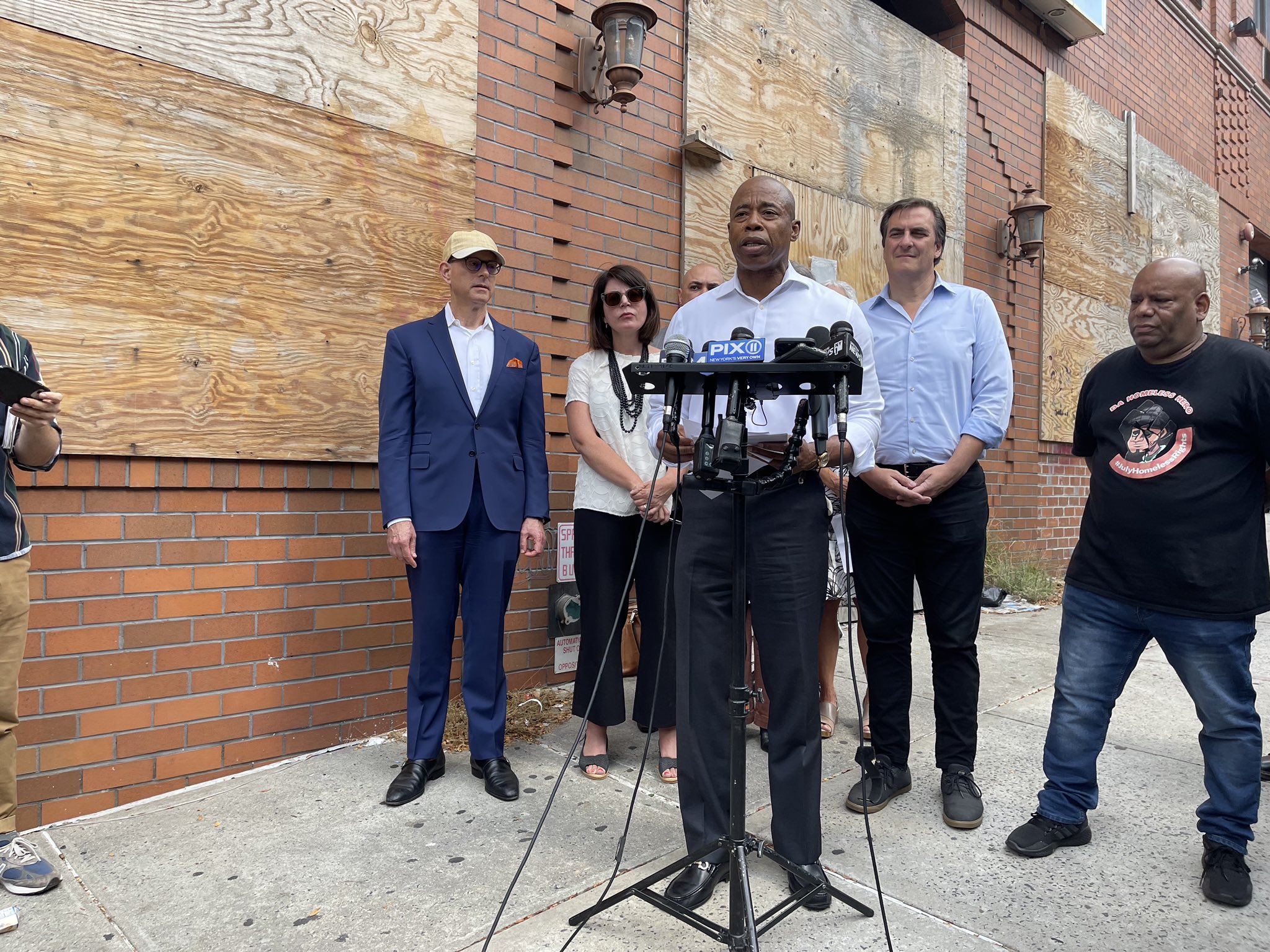
Mayor Adams discussing hotel conversions in Brooklyn (photo: @ericadamsfornyc)
Mayor Adams recently unveiled an ambitious plan to help New Yorkers living on the streets and subways by expanding access to critical social services. In the 32 years Breaking Ground has worked with this population, it has become plainly clear that our homelessness crisis is a complex public health concern that requires multiple points of service delivery to be cohesive and collaborative.
But, in order to produce the outcome we need to help the city’s most vulnerable, we must match these services with more transitional and permanent supportive housing.
There are many barriers to attaining stability for homeless individuals living on the street, including severe persistent mental illness, chronic physical health conditions, and substance use disorders. A holistic 360-degree model – which includes housing and robust social services – that meets people where they are, both physically and mentally, is time-proven to enable large numbers of homeless individuals to attain permanent stability in housing.
There is a relatively quick, smart, and affordable solution to realize Mayor Adams’ plan: convert closed hotels into transitional housing (AKA safe havens), and permanent affordable and supportive housing in as close proximity as possible to where unsheltered men and women choose to make their lives out on the streets.
Midtown Manhattan, the city’s office and tourism center, is bearing the brunt of the city’s lack of housing to address the needs of unsheltered New Yorkers. As a result, concerns over homelessness and public safety are likely preventing other New Yorkers and tourists alike from visiting these areas.
If we’re serious about both helping our most vulnerable fellow New Yorkers and also recovering economically from the pandemic, we must focus on adding more transitional and permanent housing in tandem with robust services to this area of the city. During his campaign and since, Mayor Adams has expressed support for converting closed hotels into affordable housing, but it is important that he begins to implement that plan and makes Midtown a focus area.
We’ve been here before, and we have a proven model that works to effectively address the public health and safety situation the city is experiencing today.
In the early ‘90s, Midtown was riddled with the same issues of violence and homelessness. In 1990, Breaking Ground bought and converted as-of-right the former Times Square Hotel into 652 units of affordable and supportive housing for homeless and low-income men and women.
We anchored this building with a robust on-site social services program, which has consistently delivered crucial assistance to meet each resident’s needs -- from treating their chronic issues to getting access to healthcare and helping with job placement – and that has resulted in 98% of its residents remaining housed year after year.
The result of that conversion, which is the largest and most successful of its kind to date in the nation, was a catalyst to helping large numbers of people off the streets and into safe, permanent homes. The impact of this extraordinary deal helped lead to a resurgence of the Times Square neighborhood as a global center of tourism and business.
We can replicate that model today. Right now, the opportunity to buy closed hotels in the Midtown area is ripe but will soon slip away as these assets transfer to other private for-profit owners. The Paramount Hotel and the Hudson River Hotel are just two examples of existing, vacant Midtown buildings that could quickly result in several hundred homes for those living unsheltered on the streets of Midtown and others in need of stable housing with services.
These hotels already have the existing infrastructure, such as extensive plumbing lines, needed for residential development. They represent a rare and elusive opportunity to create affordable housing at a much lower cost and 50% of the timeframe for brand new construction.
Mental health and other social services are essential to treating individuals living on city streets, but without the housing where it’s needed most, we will be missing the piece of the puzzle that brings people off the streets and inside for the long-term.
Other communities across the United States are making headway with use of shuttered hotels to address their homelessness crises. Let’s reprise New York’s leadership in the use of the invaluable, outstanding real estate opportunity to again convert closed, empty hotels so that our city and its most vulnerable residents can not only recover from the devastation of these past years, but thrive.
***
Brenda Rosen is President & CEO of Breaking Ground, New York’s largest supportive and affordable housing operator and homeless street outreach provider in New York City. On Twitter @BrGround.
***
Have an op-ed idea or submission for Gotham Gazette? Email This email address is being protected from spambots. You need JavaScript enabled to view it.
How New York City Can Make Supportive Housing Key to Ending Family Homelessness
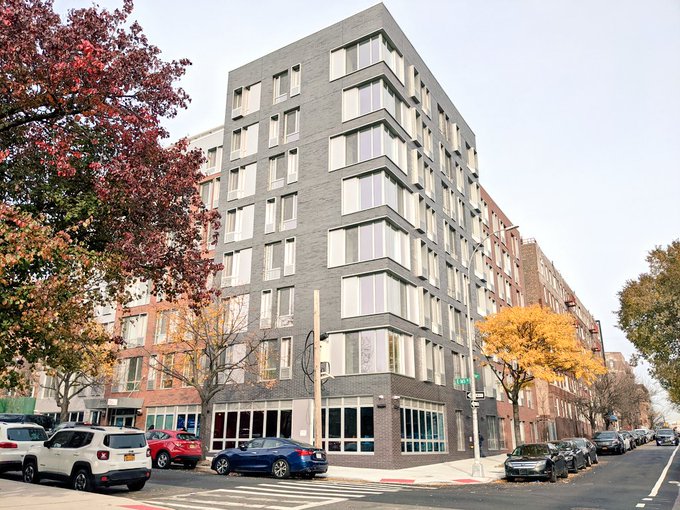
Supportive housing (photo: @newdestinyorg)
As Mayor Adams wraps up his first month on the job, one of the most daunting issues he’ll have to address is the city’s homelessness crisis. Within this larger crisis, an often-unseen demographic is particularly in need of urgent action – families with children, the largest segment of people experiencing homelessness.
While there has been a dip during the pandemic in the number of families experiencing homelessness, New York City still leads the nation in family homelessness with an estimated 30,000 women, men, and children staying in a homeless or domestic violence shelter on any given night. Mayor Adams has inherited this crisis, but also a number of successful programs to tackle it head on, including a local rental subsidy, homeless housing requirements on affordable housing construction, and the right to counsel in housing court. One resource which is in drastically insufficient supply, and which Mayor Adams has specifically noted an ongoing need for, supportive housing, is needed to reach the most vulnerable of homeless families.
For decades, supportive housing - permanent, affordable housing with onsite supportive services, has consistently proven to be the most effective way to address homelessness among some of our most vulnerable populations, including people living with mental illness, substance use history, and HIV/AIDS. However, the model has been slow to expand to homeless families, not recognizing the various social services that families need to remain stably housed.
Supportive housing is not only significantly cheaper than shelter, but it also reduces tenants’ use of costly emergency care like inpatient psychiatric treatment and emergency rooms. In New York City, a landmark study found that, on average, supportive housing reduced tenants’ use of these services and others by more than $16,000.
Supportive housing also boasts high retention rates. Only 5% of residents housed in the New York/New York III Supportive Housing Agreement returned to shelter.
Further, communities benefit from supportive housing developments, and vice versa. Tenants can become fully integrated into their new communities, contributing their talents and gaining greater stability. In fact, a 2008 NYU study showed that property values of homes near supportive housing developments actually rose at higher rates than average.
While New York City has the most supportive housing in the United States, only 11% of what the city has funded is dedicated to families and none are dedicated to domestic violence survivors.
Domestic violence is consistently cited as the number one reason for families entering shelter, with evictions the second leading cause. And while rental subsidies and other supports help many families fleeing abuse to find stability, victims of domestic violence have a higher incidence of PTSD, depression, and anxiety, leaving many with a need for support services in addition to housing. Despite this, the city’s supportive housing initiative’s eligibility requirements effectively exclude homeless domestic violence survivors.
Currently, the supportive housing program is restricted to individuals or families that are considered “chronically homeless” – defined as having spent at least a year in a Department of Homeless Services shelter, and that have a documented disability, e.g., mental illness or substance abuse. Both of these eligibility criteria are problematic for DV survivors. First, the city only counts time homeless as time spent in the primary shelter system run by the Department of Homeless Services, not the months families spend in the separate domestic violence shelters run by the Human Resources Administration. Secondly, since most survivors fear that obtaining a diagnosis would negatively impact custody proceedings, leaving their children with their abuser, supportive housing is effectively closed off as an option. As a result, there is currently less than a 1 in 1,000 chance for a family leaving an emergency domestic violence shelter to enter supportive housing.
Mayor Adams can make an immediate impact on this vulnerable population by building more supportive housing units for families and by revising these eligibility requirements. Family homelessness in New York City is a crisis requiring an emergency response. That starts with making a renewed investment in supportive housing and making it accessible to the thousands of families that become homeless each year due to domestic violence.
***
Nicole Branca is Executive Director at New Destiny Housing, a New York City nonprofit that provides housing and services to victims of domestic violence and their children. On Twitter @nbranca13 & @newdestinyorg.
***
Have an op-ed idea or submission for Gotham Gazette? Email This email address is being protected from spambots. You need JavaScript enabled to view it.
A Key Lesson of the Harlem Police Shooting
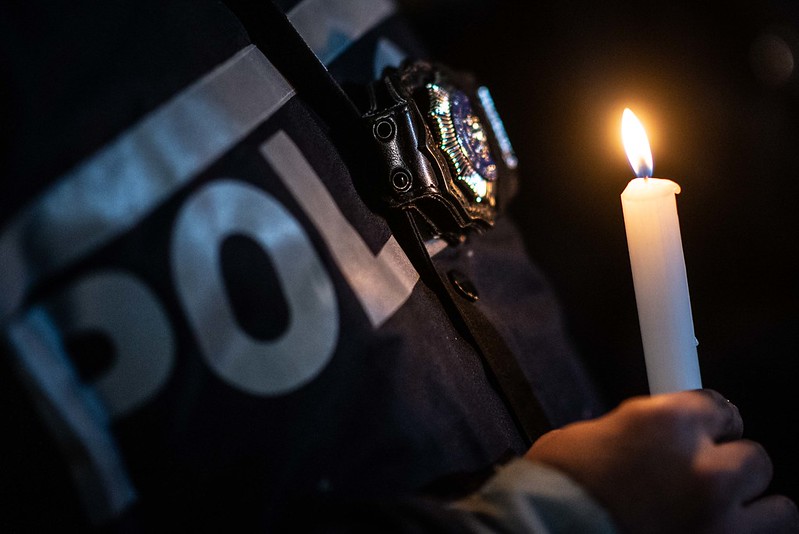
A vigil for police officers Rivera and Mora (photo: Michael Appleton/Mayor's Office)
Mayor Adams' Blueprint to End Gun Violence, just released with much fanfare, represents, regrettably, an old-wine-in-a-new-bottle agenda overly-reliant on punitive law enforcement tactics. The mayor seeks to roll back bail reform and criminalize more young people, and will return to our streets the notorious plainclothes NYPD units responsible for the deaths of Eric Garner, Sean Bell, and others. These measures would do nothing to prevent the shocking kind of tragic incident that took the lives of police officers Jason Rivera and Wilbert Mora.
The main impact of such policies will be an increase in both the arrests of young Black and Latino men and the number of New Yorkers locked up in the hellish, inhumane conditions of Rikers Island, all of it unnecessarily disrupting thousands upon thousands of lives, including the families of those arrested and jailed. As Brooklyn Assemblymember Phara Souffrant Forrest posted on Twitter, specifically in regard to Adams' proposal to harden bail policy: "Locking up people because they are poor does not keep our neighborhoods safe."
The practice that the shooting of Officers Rivera and Mora should lead our city's leaders to most seriously reconsider is the daily routine of sending police officers to handle domestic disputes. How does it make sense to send a uniformed officer armed with a gun and taser to help resolve an argument between a mother and her grown son, as was the case in the fatal Harlem incident? Add to the import of this question: that the officers so assigned can be as young and inexperienced as 22 years old, as Rivera was, and that, for better or worse, but understandably, many New Yorkers of color loathe and/or deeply distrust police officers.
Why not dispatch social workers and family counselors instead of police officers, a move that immediately helps lessen the possibility of escalation? Though it does not appear to have been the case with Rivera and Mora, we know that too many police officers approach their jobs as an opportunity to use their might to control situations, often escalating them. Why not rely on professionals whose vocation is to relieve people in stress, to use their wits and compassion to de-escalate situations and offer help, rather than officers whose training often centers on how to use force?
It is likely that had New York City had such a practice in place that the outcome last Friday night would have been different. At the very least, do we think it probable that the shooter would have thrown open the door to his room and started firing a gun had he known that it was a couple of social workers walking down the hallway in his direction? Wouldn't it be likely that Officers Rivera and Mora would be alive today? Isn't it possible that trained professionals could have calmed Lashawn McNeil, the crazed gunman, and he, too, would still be alive?
A model for this type of alternate approach has functioned successfully in two Oregon cities, Eugene and Springfield, for decades. Crisis Assistance Helping Out on The Streets, aka CAHOOTS, has teams that consist mainly of EMTs and mental health professionals trained in conflict resolution who handle mental health emergencies and domestic disputes, among other matters. Started in the late 1980s, CAHOOTS has received more public funding over the years due to its effectiveness -- by 2017 it had expanded significantly so it now responds to over 20% of all emergency calls in Eugene.
Larger, more diverse cities in the U.S. have successfully adopted the CAHOOTS model. Austin's Mobile Crisis Outreach Team (MCOT) and Denver's Support Team Assisted Response (STAR) are two programs, for example, that have recently replicated the Oregon model. New York City policy-makers should follow suit and establish an emergency response system that replaces police officers with social workers and other trained healthcare professionals. Our great city needs an approach that results in saving lives.
***
Robert Gangi is the Director of the Police Reform Organizing Project, or PROP. On Twitter @GangiFromProp.
***
Have an op-ed idea or submission for Gotham Gazette? Email This email address is being protected from spambots. You need JavaScript enabled to view it.
For State's Future, The Governor Must Say No Sometimes
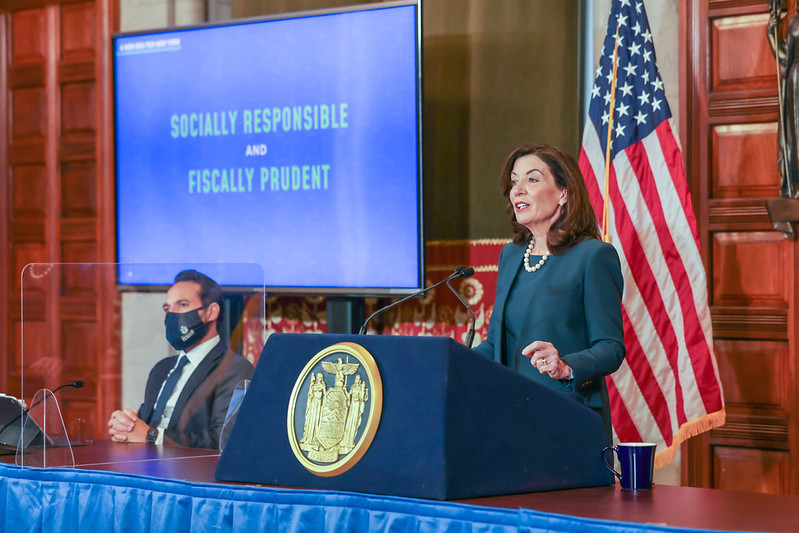
Gov. Hochul presents her budget (photo: Mike Groll/Office of Governor Kathy Hochul)
Now that Governor Hochul’s State of the State address and budget presentation have been delivered, the drumbeat of advocates, interest groups, legislators and other officials seeking increased spending will grow louder. With the primary election in only six months the temptation is strong to give everyone at least some of what they want. But, flush as the state’s coffers are right now, New York cannot afford to do it all and difficult decisions that make some important groups unhappy must be made.
The State financial plan update included in the Executive Budget shows that over the five-year period of fiscal years 2022-2027, State Operating Funds disbursements will increase by almost $26 billion, an average of 4.1% annually, higher than the growth rates prior to the pandemic. Once the substantial one-time federal funds that supplement state-generated revenue are exhausted, the State will have to fund all the programs already included in the budget on its own.
While Budget Director Robert Mujica asserts that this can be done with no deficits all the way through fiscal year 2027, he concedes that the optimistic projections for state revenue growth could change because of the continued impact of the pandemic or for other unforeseen reasons. And the generous spending included in the governor’s budget depends on the ‘temporary’ multi-year tax increases on high-earning residents and corporations adopted last year that, notwithstanding Mujica's recent assurance to the contrary, could be incentivizing wealthy businesses and individuals to leave the state.
It is noteworthy and wise that Governor Hochul proposes to set aside $5 billion in each of the next two fiscal years in reserves in case of a ‘rainy day.’ But it is difficult to believe that the Legislature will go along or that the Governor will be able to resist contentions from legislators, advocates, and others that the money is needed for a variety of worthy causes, even though she has already set aside $2 billion for covid-related needs to be allocated in consultation with the Legislature.
Some actions the governor has already taken are cause for concern. She announced that the state will fully implement the exorbitant and poorly-targeted increases in school aid required by the lawsuit filed by the Campaign for Fiscal Equity, giving all school districts increases even though over $2 billion a year is already provided to districts that have enough to fund a sound basic education for all their students. And she recently signed 16 bills passed by the Legislature that ‘sweeten’ pension benefits for public employees, the type of bills that were routinely vetoed by Governor Cuomo because of their long-term costs.
An example of the kind of well-intentioned but costly and unwise initiatives that should be avoided is the “New Deal for CUNY” campaign to make all the community and senior colleges in the CUNY system tuition free for all New York residents. A bill to implement this policy was introduced in both the Senate and Assembly and has the support of a number of members as well as student groups and the union representing CUNY faculty.
The amount of state support to CUNY (about $1.7 billion before the new additions) is two times the operating spending of the State Police and four times more than operating spending on parks and the environment. The governor’s budget adds approximately $350 million in additional operating subsidies to SUNY and CUNY as well as funding tuition assistance grants for part-time students.
Most resident CUNY students pay no tuition because of their eligibility for city, state, and federal grants. Tuition only covers about one quarter of CUNY’s costs; to eliminate this source of revenue would make the 23 campuses even more dependent on the state of New York’s economy and political calculations than is already the case. That is why legislation was enacted in 2020 to allow for regular, small increases in tuition. It should not be undone.
I am an ardent believer in the power of CUNY — I helped to launch CUNY ASAP, the most successful community college completion program in the country — and fear that eliminating its relatively small tuition payments will make its financial status more precarious.
Nor should the similar, smart practice of regular, small fare and toll increases to help the MTA keep up with inflation be discontinued. Adopted in 2009, the policy ameliorated the prior pattern of periodic significant fare and toll increases that were fiscally and politically wrenching. The 2020 increase was postponed due to the pandemic and, thanks to a $6 billion aid infusion from federal relief funds, the governor’s budget postpones the 2022 increase as well. Several types of discounts for multiple rides have also been instituted.
As ridership grows back towards pre-pandemic levels, the regular fare increases should be resumed. To maintain affordability for those with lower incomes, New York City should continue robust efforts to promote its Fair Fares program, which provides half-price transit service to lower-income residents. As with CUNY, our public transit system needs reasonable user fees to provide some level of fiscal stability.
There are a number of other steps that should be taken to put the state on a firm financial footing, such as shifting economic development efforts away from the billions spent on tax incentives and business subsidies, and rightsizing and better managing capital spending.
Saying no to seemingly attractive policies that increase state spending is going to be very tough when the state seems awash in money and there is an election imminent. It may be easy and expedient to provide as many ‘free’ services as possible now, but it will be extremely difficult to undo these policies down the road when trade-offs between these and other services for the neediest New Yorkers, like the growing Medicaid program, become necessary. For everyone’s sake and the future of New York, the governor needs to hold the line on building up reserves.
***
Carol Kellermann was president of Citizens Budget Commission from 2008 through 2018.
***
Have an op-ed idea or submission for Gotham Gazette? Email This email address is being protected from spambots. You need JavaScript enabled to view it.
4 Ways Mayor Adams and Chancellor Banks Can Support Our Most Vulnerable Students
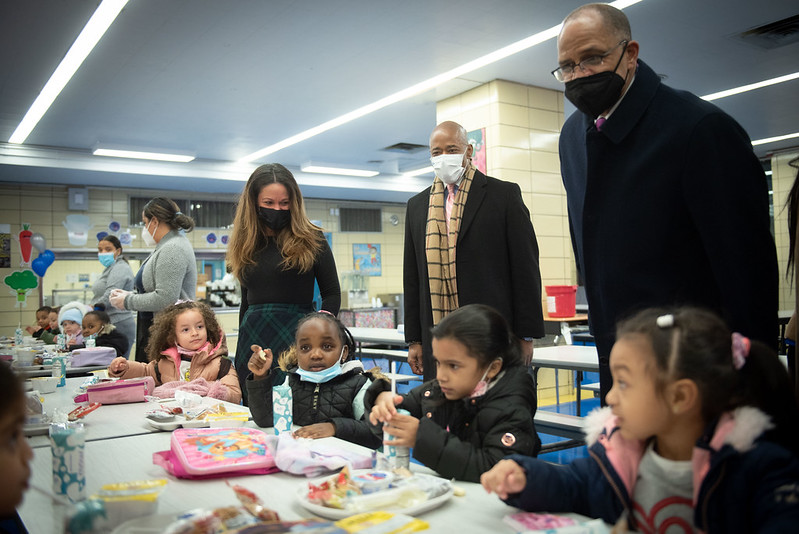
Mayor Adams and Chancellor Banks at a school (photo: Michael Appleton/Mayor's Office)
In an interview late last year, New York City’s new schools chancellor, David Banks, vowed to “transform the lives of…[New York City] children, but particularly Black and brown children who have struggled the most in this system.” While all students have struggled during the pandemic, multilingual learners, students in the foster system and in temporary housing, and students with disabilities—who are disproportionately Black and brown—have faced additional challenges, as the pandemic has exacerbated enduring opportunity gaps and academic disparities.
At the same time, the city has more resources for education than ever before. For Chancellor Banks to deliver on his promise, he must focus on targeting and increasing resources for these special student populations.
Data available from the New York City Department of Education (DOE) make it clear that many special student populations fail to receive the support they need. Students in the foster system were approximately 3.5 times more likely to repeat a grade than all other DOE students, according to data from the 2015-2016 school year (the most recent available). In 2019, less than one in five multilingual learners were proficient in math. And January 2021 data reveal increased absenteeism during the pandemic for multilingual learners, students with disabilities, and students in shelter.
With increased funding, the new city administration, working with the City Council, has a historic opportunity to invest in ambitious and equitable programs that focus on the unique needs of students from special populations, and ensure students’ access to fully participate and thrive in them.
Throughout the pandemic so far and over the next several school years, the DOE will have received immense sums of federal covid-related education aid, including $7.3 billion for elementary and secondary education (on top of regular federal funding for education) and a significant portion of the nearly $59 million in federal aid awarded to New York State for students in temporary housing. State funding is also increasing, notably through the state’s commitment to finally fully fund Foundation Aid in the coming years. This school year, the DOE is receiving $11.8 billion from the state, including $8.6 billion in Foundation Aid. With these investments, the DOE’s 2021-2022 budget is $38 billion, which includes departmental allocations toward expanding early literacy, special education, 3-K, culturally-responsive curriculum, and other priority programs.
However, some of the DOE’s programs that were funded by covid-relief dollars—such as Summer Rising—were difficult to access for many vulnerable populations, exacerbating the challenges for students who had already faced more barriers to school early in the pandemic. Some advocates attributed access challenges to limited busing options, outreach failures, and communication gaps.
One immigrant parent of two multilingual children told us that she feels like her children are excluded from new DOE programs because of language barriers. “My daughter’s school always sends me those robocalls in English and never uses a translator except for IEP meetings. They send me papers in the mail, but they are in English. I have to talk to somebody to figure out what they’re saying,” she said in Spanish. “More than anything, I want [my children] to achieve their goals.”
Children like hers, and so many others across the city, deserve better. Chancellor Banks can deliver on his commitment to transform the lives of Black and brown children by taking the following steps:
1. Utilize existing outreach structures—and create new ones—to reach special student populations and their families.
The DOE should mobilize existing staff (parent coordinators, social workers, recently-announced central foster care staff, and others) to ensure that students and their families have access to new programs. Additionally, the DOE should develop new outreach strategies with input from parents, students, and other key stakeholders who are members of historically-underserved communities, including partnering with community-based organizations that have trusting relationships with these families.
2. Create targeted academic programs and provide necessary services to enable full participation.
Students in special populations need targeted academic support provided by appropriately-trained staff to address ongoing challenges and ensure unencumbered access to programs (whether they are offered after school, in school, or on weekends), including transportation, paraprofessionals, and quality translation and interpretation services.
3. Collect and share participation data for new programs targeting special student populations.
The DOE should gather and publish this data for individual special student population groups and disaggregate by race, ethnicity, gender, and geographic district to better understand who has access to city programs and address gaps.
4. Develop trauma-informed programming that targets the whole student.
Supports must help students in special populations process their emotions and help them to persist through their education. School staff must be trained to understand the effects of trauma and adverse childhood experiences, how they manifest in the classroom, and how they can encourage positive social-emotional interactions.
The pandemic has highlighted systemic challenges within our schools that impact all students––especially the most underserved. Students in special populations need targeted supports and transformative change. Mayor Adams and Chancellor Banks have a historic opportunity and unprecedented funding—including Governor Hochul’s proposed future increases in state aid—to ensure these students have the opportunities they need to succeed. They must make good on their promise.
***
Alejandra Vázquez Baur and Chantal Hinds are Policy Entrepreneurs at the Next100 think tank, where they work on issues related to educational equity, students involved in the foster system, and immigration justice. On Twitter @TheNext100.
***
Have an op-ed idea or submission for Gotham Gazette? Email This email address is being protected from spambots. You need JavaScript enabled to view it.
How Our Parks Can Save Our City

Cunningham Park, Queens (photo: @NYCParks)
New York City’s parks literally saved lives during the pandemic. In my community of Jackson Heights and Elmhurst, our open spaces allowed us to escape the physical, mental, and social constraints of quarantine into fresh air. Today, our parks, pools, playgrounds, and plazas are places of reconnecting and healing for a community pushing forward from its days as the epicenter of a global crisis.
Across our city, parks and public spaces will be essential to meeting the multiple challenges we face, from health care to climate change and more. We must recognize the extraordinary value of our park system and deepen our investment for all neighborhoods, and for future generations. Every community needs and deserves the space to thrive.
Beautiful, functional parks are not luxuries only for certain neighborhoods to enjoy at the expense of others. They are part of our critical infrastructure. But, like so much other infrastructure, poor communities of color lack access to high-quality parks. On average, neighborhoods of color have 33% less park space per person than predominantly white neighborhoods. In an extreme example, the historic Upper West Side is sandwiched between 840 acres of Central Park and 310 acres of Riverside Park, while NYCHA playgrounds are in disrepair and have been neglected for decades. In my district, the immigrant communities of Jackson Heights and Elmhurst, we have fewer than 12 acres of public parks, some of the least park space per person in all of New York City.
This uneven distribution of park space and playgrounds is no accident. Federal maps of New York City from the 1930s show neighborhoods where the government decided not to invest at all due to the “infiltration” of Black people and immigrants. Now, these same communities are “urban heat islands” where sparse tree cover and exposed asphalt cause temperatures to soar to deadly highs each summer. In so many ways, the lack of green space caused by disinvestment causes real harm to the most vulnerable New Yorkers and exacerbates the impacts of the climate crisis on communities of color.
Our parks are also deeply connected to our city’s civic health. From Diversity Plaza in Jackson Heights to Maria Hernandez Park in Bushwick, New York City’s parks and public spaces have been focal points of political organizing and mass movements. In 1970, Stonewall activists seized Christopher Street for the first Pride. The occupation of Zuccotti Park mobilized a generation of activists. In 2020, Union Square, Foley Square, and Grand Army Plaza were gathering points for the response to the police murder of George Floyd. To deprive people of public space is to restrict their political power.
And this only scratches the surface of how parks impact our city. Bioswales and planter boxes absorb stormwater to prevent flooding. Street trees reduce temperatures on hot summer days. Open streets, playgrounds, and gardens provide places for social interaction, for our youngest kids to our elders and everyone in between. Pedestrian plazas drive foot traffic to local businesses. Public spaces can help reorient our city towards people and our needs – here in Jackson Heights, we cherish 34th Avenue, the city’s “gold standard” Open Street, which we should further transform into a linear park.
In short, our parks and other public spaces are a matter of social justice. As the new Chair of the City Council’s Committee on Parks and Recreation, I believe we must use our resources and our vision to create parks where none exist, and systematically invest in green spaces in neighborhoods that have long been ignored. Our parks have the power to heal and transform our city.
***
Shekar Krishnan represents Elmhurst and Jackson Heights in the New York City Council. He is the Chair of the Committee on Parks and Recreation. On Twitter @voteshekar.
***
Have an op-ed idea or submission for Gotham Gazette? Email This email address is being protected from spambots. You need JavaScript enabled to view it.
Who is NYC Chief Technology Officer Matthew Fraser and Will He Deliver What’s Desperately Needed?
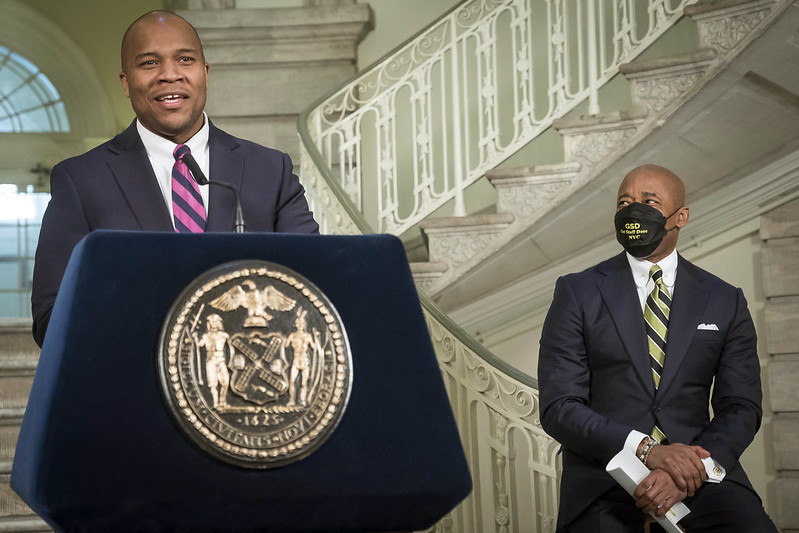
NYC CTO Matthew Fraser with Mayor Adams (photo: Ed Reed/Mayoral Photography Office)
The de Blasio administration acknowledged that New York City desperately needs a Digital Service Organization (DSO) when it announced less than a month before the mayor left office that it wants to hire people for a new “NYC Digital Services” unit that would apply best practices in modern, open-source software development to New York City’s many software and technology challenges. Within two weeks of those first job postings going out, the inevitable happened: Mayor Adams announced a new Chief Technology Officer (CTO) for the start of his administration on January 1.
The new CTO is Matthew Fraser, and thanks to Adams’ Executive Order #3, he will be in charge of a newly-created Office of Technology and Innovation that will consolidate nearly a half dozen existing technology agencies and units under its leadership, including the Department of Information and Technology (DoITT), Cyber Command, 311, and the Mayor’s Office of Data Analytics (MODA).
So who is Matthew Fraser and what does he need to do?
A simple search for “Matthew Fraser New York City” on Google turns up Linkedin and Twitter profiles that give us some clues that can help us answer the question City & State New York flatly asked, “Could Eric Adams’ new tech chief bring NYC out of the dark ages?”
Fraser’s Linkedin shows that he was Deputy Commissioner and Chief Information Officer of the NYPD for nearly two years. Before that he worked at Gartner, a technology consulting corporation, as a Director of Consulting Services. And before that he served for four years at NYPD doing technology strategy and nine years doing technology project management for “the City of New York.”
To my knowledge, the NYPD has not adopted any of the DSO-style practices for which I and many other technologists frequently advocate. The NYPD has no presence on Github, which is a popular code sharing platform where many prominent DSOs such as the federal government’s 18F and the United Kingdom’s Government Digital Service publish code, gather user feedback, and recruit technical talent. Indeed, NYPD clearly doesn’t care about Github as the github.com/NYPD profile is owned by someone with an anime avatar. From the perspective of the DSO community, which views posting code and issues to Github as a core tool in their workflows, NYPD’s Github situation is one degree more embarrassing than DoITT’s empty Github profile. At least DoITT has secured a decent screen-name!
Gartner is well-known as a technology research company, but also one of the guardians of the existing technology status quo and a primary pusher of the type of expensive proprietary corporate software that has failed New York City government agencies and residents over and over and over again.
Gartner and its big corporate IT software vendor peers view the open source-based DSO movement as a threat to their core business. They know that if New York City gets good at using open-source software to build its own solutions, then proprietary IT vendors can kiss hundreds of millions of dollars of contracts goodbye. Don’t take my word for it. Look at how the "Gov Tech" industry lobby groups reacted to the success of 18F, the country’s largest DSO. It aggressively lobbied Congress to undermine 18F’s ability to compete with corporate vendors!
But just because Fraser worked for Gartner and the NYPD doesn’t mean he’s beholden to the IT vendors that orbit those entities or that he won’t be able to deliver modern digital services to New York City residents. Let’s look to Fraser’s Twitter profile for more insights.
On Twitter, as of January 20th 2022, the @NYPDTECH handle still carries Matthew Fraser’s name and picture, and a banner image displaying CompStat, the police department’s data-centric crime-reporting tool. The content of the feed is generic NYPD stuff – nothing particularly tech focused. We do get this short but kind of charming video of Fraser talking about his work and perspective. But we can also read between the lines.
Fraser, in this Twitter profile, is the embodiment of NYPD technology. And if there is one thing Mayor Adams has made clear about his plans for the city, it’s that he wants to CompStat New York City.
CompStat is a system for collecting, analyzing, and visualizing policing data, first pioneered and launched in New York City in 1994 and now utilized throughout the world. It’s not a specific computer program but rather an approach to using databases, GIS, and data analysis tools to organize information about crime and policing, which is then used for situational awareness, success metrics, commander assessment, accountability, and more. The NYPD, and Adams, are extremely proud of CompStat.
From the New Yorker article:
Adams was part of a team that helped put together the early versions. “I was just this computer geek,” he said. “We were building out the first layers of this new form of thinking. We had no idea we were going to make this impact. Trust me, it was unbelievable.”
Indeed, the NYPD loves data reports and dashboards, and if Fraser’s Linkedin Activity is any indication, putting them together is a big part of his work. A quick analysis of the reports and dashboards section of the NYPD website reveals they’re relying on proprietary Microsoft technology, not the open-source technologies that a DSO would use to build the same type of interfaces.
It’s probably fair to say that Fraser isn’t as familiar with open-source solutions as many civic technologists would like him to be, but that’s also OK. Anyone who builds real systems that have real users knows that you’ve got to build with what works. And if Microsoft is delivering for the NYPD, and they’re doing so for about $2 million per year worth of contracts, then so be it. But the challenges he’s about to face will require far more complex work.
As head of NYPD technology, Fraser has had the benefit of working within a single agency, controlled by a central bureaucracy with a (somewhat) unified system of contracting and assembling technology solutions. In his new role he has a mandate to integrate the city’s main cross-agency technology programs into a coherent strategy, and he will inevitably come up against many of the same problems that arose when the Obama administration first attempted to launch their HealthCare.gov program, which ambitiously attempted to tie a lot of proprietary software made by different commercial vendors together. It failed massively.
A tremendous amount of ink has been spilled about why healthcare.gov failed initially and the crack teams that emerged to fix the problem using open-source components and startup-style development strategies. After fixing HealthCare.gov, those people went on to organize the federal government's first DSOs: the US Digital Service and 18F.
Now, 10 years later, there is a tremendous wealth of books, best practice manuals, organizational models, and open source code available to help overcome the difficulties of building modern digital services inside government. Thanks to all these advances, it has never been easier, technically-speaking, to fulfill the ambitious, reasonable (and dare I say essential) dream of CompStat for the city.
But to access this wealth of knowledge, Fraser will have to venture out of the comfortable world of proprietary software vendors and monolithic contracts and into a less familiar — but very friendly and collaborative — open-source ecosystem of government digital services. If he and Adams are truly guided by the higher purpose of revolutionizing municipal government in the vein of how CompStat revolutionized policing, then they could be a massive success.
Technologists all over this city are rooting for Fraser and Adams, and I have no doubt many would be willing to roll up their sleeves and get to work on the city’s behalf if Fraser indicates he is ready, willing, and able to adopt DSO practices.
A good first step: organize a presentable Github profile for his new office.
***
Devin Balkind is a civic technologist, software producer and nonprofit executive passionate about digital government reform. He leads the WeGov.NYC project. On Twitter @DevinBalkind.
***
Have an op-ed idea or submission for Gotham Gazette? Email This email address is being protected from spambots. You need JavaScript enabled to view it.
New York History Offers Insights for Governor Hochul
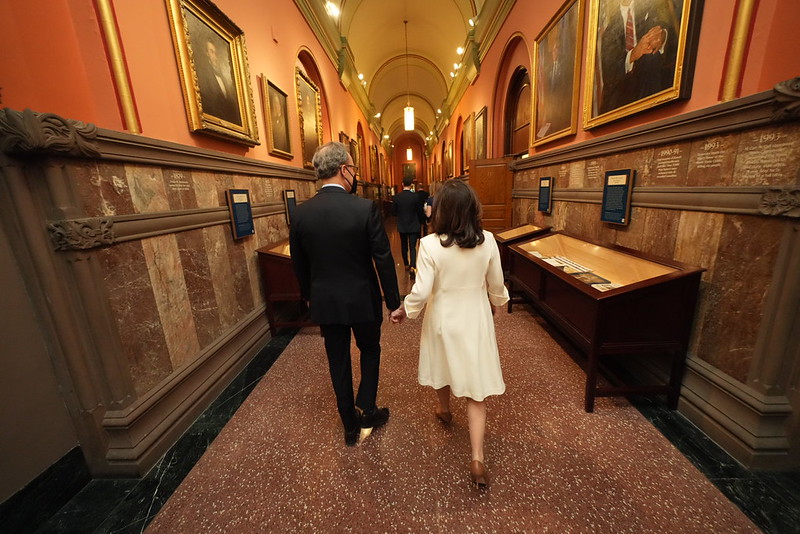
Gov. Hochul in the Hall of Governors (photo: governor's office of Kathy Hocul)
Governor Kathy Hochul’s recent State of the State address promised a new era of political collaboration and offered a sweeping agenda to improve the state. “We will share success,” she promised. “We will find common ground. We will restore trust in this government.”
At the same time, she exhibited a personal modesty that set her apart from her predecessor, Andrew Cuomo. “I didn’t come here to make history,” she said. “I came to make a difference.”
As historian Allan Nevins wrote, "to be governor of New York…was to occupy a position which might be distinguished or unimportant, according to the man who held it." Governor Hochul may not have come to Albany to make history but she has already done so just by being the first woman to hold that position and by restoring decorum and public confidence in the Executive Chamber.
“I have a deep reverence for our state’s remarkable past,” she said in her address. There may be some helpful insights from that remarkable past, particularly the strategies of New York’s strongest previous governors, that she could find helpful.
Define An Expansive Vision
Great governors offer dramatic visions for their state and proceed to make them real. Gov. DeWitt Clinton (1817-23, 1825-27) championed constructing the Erie Canal, from Troy to Buffalo, the nation's most important public works project in the 19th century. The canal was a dramatic success that propelled New York City and State to national preeminence. Clinton was a visionary (foreseeing the canal as an engine for growth), advocate (crafting appeals to bring together "communities of interest": agriculture, commerce and manufacturing) and leader (negotiating approval from a factious legislature).
He was also a shrewd administrator. He worked out financing to build the canal entirely from state resources, particularly bonds. He realized that either starting at the Hudson River in Troy and building westward, or at Lake Erie at Buffalo and building eastward, might mean that the canal stopped mid-state if resources or public support waned, Clinton shrewdly began construction at Rome in 1817. That was near the middle of the state where costs were lowest. Building both east and west, toward the Hudson and Lake Erie, encouraged continued statewide legislative and public support until the enterprise was completed in 1825.
Hochul’s speech provided her take on New York’s inspirational historical greatness. “While we may be imperfect, New Yorkers have always been the risk-takers, entrepreneurs, the innovators, the builders, the immigrants, the students, the true believers and the dreamers who know that there truly is only one New York”
Demonstrate Highly-Visible Personal Leadership
George Clinton, New York's first and longest-tenured governor (1777-95, 1801-04), set the tone for taking bold action when models were lacking. Clinton, a patriot general fighting the British when he was elected, expressed determination in his first speech to be a strong governor and to "exercise for the advantage of the people the powers with which they have invested me." That set the tone for the history of executive leadership in New York.
After his inauguration, Governor Clinton resumed command of patriot troops fighting in the Hudson Valley. As his military duties eased, he turned full-time to the precedent-setting work as governor. He set up state government, established New York's first system of taxation and fiscal management, and supported public education and the building of roads and early canals.
In 1786, the governor personally commanded state militia troops to confront an armed anti-tax uprising that had started in Massachusetts and threatened to spread into New York. Two years later, he led the militia in suppressing a riot in New York City. The governor, on the front lines, was injured when a rioter threw a rock.
Act Boldly In Crises
Hochul has promised to confront COVID- 19, stem New York’s loss of population, and substantially strengthen public education. She is aligning with successful governors who take charge and dramatically meet critical issues.
Gov. Franklin D. Roosevelt (1929-1933), alarmed by rising unemployment during the Great Depression after the Stock Market “crash” of 1929, called the legislature into emergency session in August 1931. “New York cannot wait,” he warned in a dramatic address to the lawmakers. “You face… the problem of providing immediate relief."
He proposed a Temporary Emergency Relief Administration (TERA), its name strategically selected to connote urgency but also impermanence. This strategy addressed the need for immediate action but also disarmed critics who accused Roosevelt of pushing New York into a permanent welfare state mode.
FDR skillfully outmaneuvered his Republican opponents in the legislature by threatening to veto their weak alternative proposal and blame them for inaction. The opposition folded and the TERA bill passed. The new agency improvised and succeeded, and became a model for similar New Deal recovery and relief agencies when Roosevelt became president in 1933. As federal programs ramped up, the need for the state program diminished and, true to FDR’s promise, TERA expired in 1937.
Hochul already has FDR in mind as a model. “First as governor and then as president, FDR literally rebuilt the economy from the ground up after the crash of 1929,” she said in her inaugural address. “More than giving people jobs, he gave people hope.”
Blend Short-Term Wins With Long-Term Impact
Governor Theodore Roosevelt (1899-1901) is a good model of executive energy (he often walked briskly several blocks from the Executive Mansion and bounded up the Capitol steps two at a time); openness (twice-daily candid interviews with reporters); and pragmatic compromise (keeping the public interest paramount but dealing with the political reality of political parties dominated by bosses). U.S. Senator Thomas Platt, the de facto head of the state Republican Party, later recalled that TR had promised to consult him on policy and appointments. “He religiously fulfilled this pledge,” said Platt, “although he frequently did just what he pleased.”
Roosevelt chalked up some impressive short-term achievements. He persuaded the legislature to pass a law to tax business franchises despite opposition from within his own Republican Party. TR was the first governor to issue an order mandating the cleanup of a waterway. He also left a long-term legacy. A commission he appointed recommended abandoning the by-then-aging Erie Canal in favor of a modern, new Barge Canal, finally achieved in 1903 (and still in operation today). Another commission recommended consolidation of scattered state education policy in a new State Education Department. TR endorsed it but political bickering delayed implementation until 1904.
Manage State Finances
Many governors have won initial public confidence by committing to cut waste and reign in non-essential public spending. Hochul has promised more efficient state spending and tax relief for New York’s middle class. Effective fiscal management is a hallmark of New York’s leading governors.
"New York faces the problem of fitting the aspirations of public service into the reduced limits of its treasury," said Governor Herbert Lehman (1933-42) during his first inaugural address, in the depths of the Great Depression. He had inherited a $106 million state deficit. Lehman got a fiscal break. As the Depression waned and military spending at the beginning of World War II ramped up, state tax revenues increased. Lehman made the most of public resources. He was a skilled administrator who dramatically expanded social programs, unemployment, and other areas. He left the state with an $80 million surplus in 1942.
These examples suggest that successful New York governors are strong leaders, visionary but also pragmatic, idealists but also political realists, flexible but also principled and steadfast. Hochul should find that their strategies and tactics are worthy of consideration as she forges ahead with her governorship.
***
Bruce W. Dearstyne is a historian in Albany, NY. SUNY Press is publishing the second edition of his book The Spirit of New York: Defining Events in the Empire State’s History and his new book The Crucible of Public Policy: New York Courts in the Progressive Era later this year.
***
Have an op-ed idea or submission for Gotham Gazette? Email This email address is being protected from spambots. You need JavaScript enabled to view it.
In the Face of Anti-Asian Violence, We Want Budget Justice
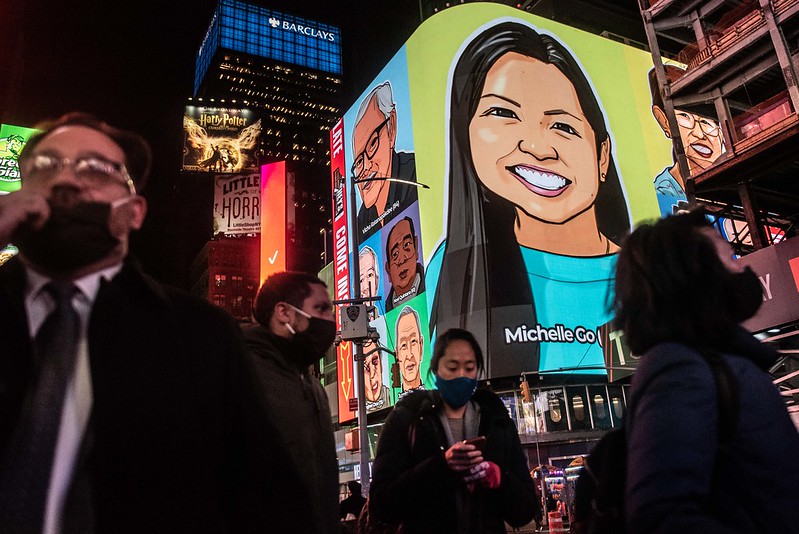
A remembrance for Michelle Alyssa Go (photo: Michael Appleton/Mayor's Office)
Over Dr. Martin Luther King Jr. Day weekend, 40-year-old Michelle Alyssa Go was pushed from the Times Square subway platform to her death. This tragedy follows a year that saw a 361% increase in anti-Asian hate crimes and came less than two weeks after Mayor Adams announced his plans to increase police presence in the subway system. Much like the federal response to the March 2021 Atlanta spa shootings, where money poured into local police departments under the guise of fighting anti-Asian hate crimes, we are once again seeing our government prioritize turning to the police to solve issues of public safety.
Around the country, Asian Americans have grappled with what community safety might look like amid a pandemic, a rise in anti-Asian hate crimes, and calls to defund the police. But in response to tragic and awful incidents of violence against Asian Americans, as Murad Awawdeh of the New York Immigration Coalition correctly argues, “we can’t police our way out of this.”
Not only is throwing more police at the problem of anti-Asian violence incongruous after sustained uprisings against police brutality, but it also does little to prevent this violence. The root of anti-Asian violence is not individual acts of hate or even so-called “random attacks,” but rather white supremacy and austerity that seeds systemic violence. Instead of expanding policing, New York City must turn its attention to budget justice.
In addition to divesting from the police, the road to justice requires direct democracy on how and where to spend public dollars. Direct democratic initiatives like participatory budgeting (PB) can help us articulate concrete, tractable policy demands for community safety for all New Yorkers.
Through PB, everyday residents, rather than elected representatives, decide how public dollars are spent. Gathering online and in person, residents connect with one another, weigh community needs, and develop new projects.
This year, for example, the New York City Civic Engagement Commission, with leadership, brainstorming, and decision-making from young people ages 9 to 24, invested $100,000 in youth organizations to make the city safer. Past projects funded through other PB programs include innovative bystander/“upstander” training for those hoping to safely intervene when they witness harassment or violence. In City Council District 39, residents voted to fund self-defense workshops for Bangladeshi and Muslim women. They did so as a true statement of racial solidarity; neighbors helping neighbors get what they need.
In 2019, we saw a record breaking 33 City Council members participate in PB to bring direct democracy to their districts. However, due to COVID-19, funding and participation was cut short in 2020 and the project was shelved when our communities needed help the most. But thankfully, vocal advocacy has renewed this vital form of community engagement and this year 15 Council members are running PB.
The connection between budget justice and racial justice is not a new idea. During the summer of 2020, Occupy City Hall to Defund NYPD camped out in front of City Hall for more than a month, asking for at least $1 billion to be cut from the police budget and invested back into communities. The Movement For Black Lives (M4BL), a coalition associated with the Black Lives Matter movement, has also articulated direct democratic community control, and specifically PB, as central to anti-racist work.
New York City must combine participatory budgeting with calls to defund the police, to satisfy both the need to divest and invest parts of the budget justice equation. During summer 2020, a group of Brooklyn City Council candidates, including myself, wrote about how to use the power of City Council to defund the police, arguing that community control of public budgets includes the expansion and much-needed reform of participatory budgeting as well as removing police from social services and the school system. Only through investing in the services that heal our communities and address austerity can we create the conditions for real public safety.
In Council District 39 (represented by one of the authors), the Participatory Budgeting District Committee is currently leading its 11th cycle. It joins 14 other Council districts in implementing PB this year, despite difficult pandemic conditions. Whereas electoral politics typically engage with well-resourced constituents, PB can engage traditionally marginalized ones, including non-citizens, undocumented immigrants, and youth. In many districts, PB has successfully and intentionally centered marginalized voices and transferred power to women of color in meetings – often through simple, thoughtful acts like repeated invitations, childcare provision, and having appropriate snacks on hand.
Impressively, research coordinated by the Community Development Project shows that one-quarter of PB participants in New York City reported being ineligible to vote in regular elections, and that Asian American participation in PB was almost three times higher than in regular local elections.
Participatory budgeting needs more resources and thoughtful implementation to be successful. At its best, PB enables us to fund and practice new forms of critical care and racial solidarity. But without an explicit focus on equity and training for city workers as well as participants, PB can be set up to fail. Well-resourced groups can dominate the process, and innovative project proposals can be dismissed as “unrealistic” or discarded because of technicalities rather than substance.
The creative and impactful community projects highlighted above only came about when PB was expanded to potentially include short-term projects alongside long-term infrastructure. Participatory Budgeting is inherently political, and should be explicitly tied to budget justice and racial equity goals, such as those coordinated by the city’s Racial Justice Commission. With citywide participatory budgeting’s future now in limbo because Mayor de Blasio never adequately funded it, the new mayor and new Council speaker must resuscitate PB, with these priorities in mind. For the long-term safety of all New Yorkers, we can’t afford not to.
***
City Council Member Shahana Hanif represents District 39, including the neighborhoods of Borough Park, Carroll Gardens, Cobble Hill, Columbia Waterfront, Gowanus, Kensington, Park Slope, and Windsor Terrace. Professor Celina Su is the Marilyn Gittell Chair in Urban Studies at the CUNY Graduate Center and a Professor of Political Science at Brooklyn College. On Twitter @celinasu and @ShahanaFromBK.
***
Have an op-ed idea or submission for Gotham Gazette? Email This email address is being protected from spambots. You need JavaScript enabled to view it.
Housing Courts Must Change: Every Tenant Should Have Right to Counsel as Eviction Moratorium Lifts
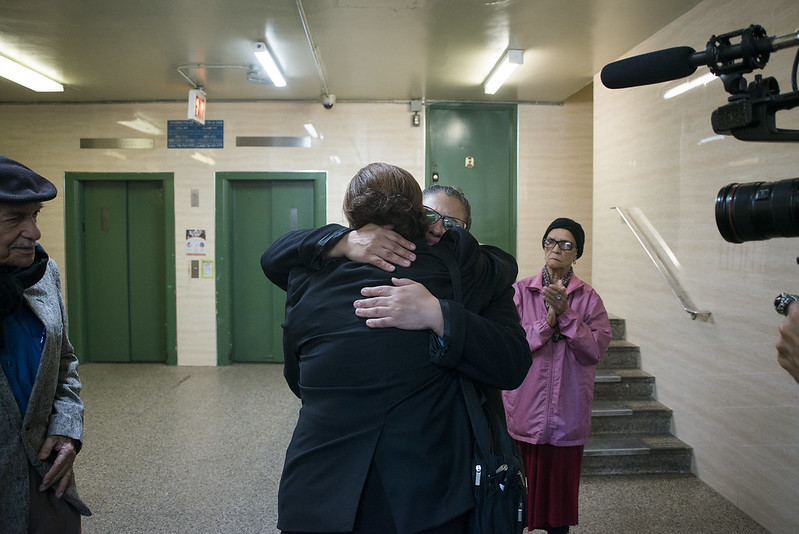
New York housing (photo: Jeff Reed/City Council)
New York City’s Right to Counsel (RTC) has proven to be successful at stopping evictions and protecting tenants’ rights. Evictions in New York City have plummeted, landlords are suing tenants less, and almost everyone who fights their eviction with an RTC attorney stays in their homes. This has been especially true during the pandemic. Amidst ever-changing laws and complicated government relief programs and administrative orders, RTC has been critical.
And it’s now even more critical with the expiration of the state’s eviction protections.
When the RTC law first passed, almost no tenants had attorneys when facing eviction in court. This meant that in order to get to a place where all income-eligible tenants had RTC (about 65-80% of tenants in court at the time), legal services organizations needed time to hire, train, and support the new attorneys, paralegals, and support staff.
In the last four years, New York City went from less than 100 tenant attorneys to over 600. In addition, the city’s Office of Civil Justice (OCJ) needed time to set up the infrastructure, coordinate with the state-run courts to implement this first-in-the-nation, new legal right. For all of these reasons and more, RTC had a five-year phase-in plan, giving the city until July 2022 to fully implement RTC for all eligible New York City tenants. However, once the COVID-19 pandemic hit, this timeline could no longer be justified.
The pandemic has devastated our city in so many ways. More than 400,000 New York City households are unable to pay rent, owing over $1 billion in rent. While the state’s rent relief program has helped, it is not enough. And it won’t keep tenants out of court. The rent relief program and myriad of other laws passed by the State Legislature created a confusing set of rights that landlords will surely take advantage of, as they have across the country. Tenants deserve to have their rights defended, making Right to Counsel so incredibly critical at this moment.
Soon after the COVID-19 pandemic hit, the city recognized that it could no longer move some cases forward with an attorney and others without – everyone deserves representation in court regardless of income. While this shift in implementation happened in part because so few cases were moving forward thanks to the various eviction moratoria, it was the right response morally. Our bill, recently made into law, made this model permanent, speeding up the full implementation of RTC by more than a year.
While the income restrictions haven’t been lifted under the law (this is something our statewide RTC bill would do), New York City has granted a blanket income waiver to all cases allowing legal services providers to represent tenants regardless of income.
This is an amazing victory for tenants. But, how will it work?
If there wasn’t enough legal capacity for all income eligible tenants before the pandemic, how will there be enough now given the unprecedented number of families we expect landlords will sue as soon as the eviction protections lift? How can we ensure legal services providers won’t enforce the income restrictions themselves, as a way to protect their capacity? How can we ensure that legal services aren’t overwhelmed with cases and that tenants get the thorough and zealous defense they deserve? After all, as our eviction crisis monitor shows, the neighborhoods hit hardest by COVID-19 are also being targeted for evictions. It would be unconscionable if these mostly Black and brown tenants could not get the representation they deserve.
The answer is simple: Move only the cases where tenants are represented forward and adjourn all the rest until the legal services organizations have capacity to take more cases.
These adjournments happen in other courts, like family court, where there is a Right to Counsel. There is a legal basis for judges to grant repeat adjournments for the assignment of counsel and due process requires it, plus judges have a broad discretion to adjourn cases as they see fit. Thanks to New York State’s Housing Stability Tenant Protection Act, housing court judges have much greater ability to adjourn cases.
The legal arguments for multiple and prolonged adjournments for the purposes of Right to Counsel assignment, both in terms of New York City’s Right to Counsel law and also as a matter of due process, are clear.
Cases have already slowed down during the pandemic, and there was no great collapse. There is no reason to return to the fast-paced, high-volume courts of the past. They were unjust then, and they would be a death sentence now, especially as COVID-19 cases recently surged across New York City due to the Omicron variant. As we have done over the past two years, slowing down the court system is the only moral response.
***
Corinthia A. Carter is the president of Legal Services Staff Association (LSSA 2320), which represents the more than 600 secretaries, paralegals, receptionists, process servers, social workers, attorneys, and other non-management staff of Legal Services NYC and Mobilization for Justice. Beverly Rivers is a tenant leader with the Flatbush Tenant Coalition, a member-led group of tenant associations in Flatbush, East Flatbush, and South Crown Heights working collectively to build tenant power.
***
Have an op-ed idea or submission for Gotham Gazette? Email This email address is being protected from spambots. You need JavaScript enabled to view it.




